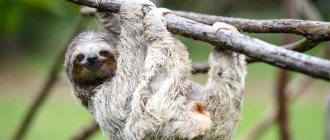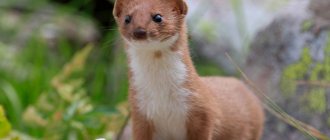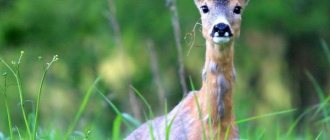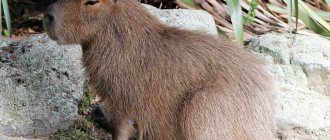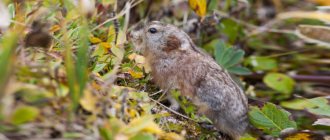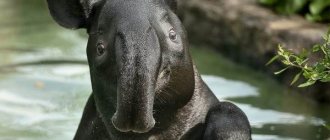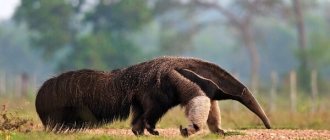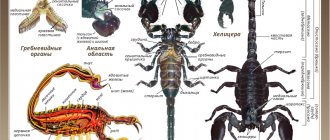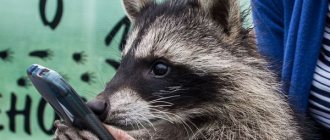- Wild animals
- >>
- Mammals
Surely many have heard about such a unique animal as the Tasmanian devil . Its mystical, scary and threatening name speaks for itself. What kind of life does he lead? What habits does he have? Can his character really be called sinister and devilish? Let's try to understand all this in detail and understand whether this unusual animal lives up to its not very pleasant nickname.
Scientific classification
- Kingdom : Animalia (animals)
- Phylum : Chordata
- Class : Mammalia (mammals)
- Order : Dasyuromorphia (carnivorous marsupials)
- Family : Dasyuridae (marsupial martens)
- Genus : Sarcophilus (marsupial devils)
- Species : Sarcophilus harrisii (Tasmanian devil)
The name "Tasmanian Devil" comes from the aggressive nature of the animal, as well as the devilish cry it makes.
Geographical distribution range
Currently, the Tasmanian devil is almost universally found only in Tasmania and Robbins Island, which connects with the island state at low tide. The northwestern population is found predominantly south to Macquarie Harbor and west to the Forth River.
Photo: DAVE WALSH
Although fossil evidence suggests that the Tasmanian devil once occupied much of mainland Australia. Scientists have suggested that the current absence of Tasmanian devils in many previously occupied areas is due to competition with introduced dingoes, which reproduce more quickly.
Where does the Tasmanian devil live?
Photo: Tasmanian devil in nature
Judging by the name of the predator, it is not difficult to understand where it has its permanent residence. The marsupial devil is endemic to the island of Tasmania, i.e. it is impossible to meet it in natural conditions anywhere other than this place. Previously, the predator inhabited the Australian continent and was quite widespread there, this was the situation about six centuries ago, now the marsupial trait does not exist in Australia, a number of negative anthropogenic factors led to these sad consequences.
Firstly, the reason for the disappearance of the Tasmanian devil was the introduction of the wild dingo dog to Australia, which began an active hunt for the marsupial predator, greatly thinning its population. Secondly, people began to mercilessly destroy the devil because of his predatory raids on chicken coops and bandit attacks on lambs. So the marsupial devil was completely exterminated and disappeared from the Australian continent. It’s good that they didn’t have time to kill it on Tasmanian soil, but when they realized it, they passed a law that imposed a strict ban on any hunting activities regarding this unique animal.
Nowadays, animals prefer to live in the north, west and central parts of Tasmania, staying away from people who are dangerous.
Animals love:
- forest areas;
- sheep pasture areas;
- savannas;
- mountainous, inaccessible terrain.
Natural habitat
These marsupials are abundant throughout Tasmania, except in areas where there has been extensive fragmentation of their habitat and deforestation. They are most numerous in coastal heathlands and grasslands where agriculture maintains a constant supply of carrion. Tasmanian devils also prefer to be surrounded by dense tropical and dry forests. Their burrows are usually located in hollow logs, burrows, or cave recesses.
They are often seen on the roads, where they pick up dead animals hit by drivers. Often they themselves become victims of car accidents. There are road signs everywhere in Tasmania warning of the possibility of the Tasmanian devil appearing on the road.
- Terrestrial biomes : savanna, grassland, tropical forest
- Aquatic biomes : coastal areas
Natural cleaners
Tasmanian devils can smell carrion from 1 km away
. In fact, Tasmanian devils are beneficial members of the ecosystem in their natural habitat. Thanks to their tendency to hunt sick animals and eat carrion, they resemble “natural vacuum cleaners.” Removing sick animals and eating carrion prevents the spread of infection to other fauna.
Marsupial devils also protect their native fauna by hunting feral cats, which pose a threat to some Tasmanian birds. They also control Tasmanian foxes, which harm the island's unique biosphere. On top of that, these marsupials have cultural value, serving as icons of their namesake island and attracting tourists who support Tasmania's economy.
Characteristic anatomical features
Photo: Kunal Kalra
The Tasmanian devil is the largest living carnivorous marsupial. It is characterized by a strong, squat build and a disproportionately massive head, as well as a long tail, which makes up up to half the total body length. Fat cells accumulate there, and therefore healthy individuals can be easily distinguished by their very wide tails. The Tasmanian devil has slightly elongated hind legs, which is not typical for other marsupials. This body structure allows him to run at a speed of 13 km/h for short distances.
The front feet of Tasmanian devils have five long toes at the end - one located at the side and four pointing forward. Thanks to this, animals can retain prey. The hind feet have four toes with non-retractable claws.
Photo: Meg Gerrard
The Tasmanian devil has excellently developed jaw muscles, the structure of which resembles the jaws of a hyena. It has prominent canines, three pairs of lower and four pairs of upper incisors. The predator can open its jaws at an angle of 75-80 degrees, which allows the Tasmanian devil to generate enormous power, thanks to which it can bite through thick skin, tear muscles, tear off meat and crush bones. The bite of the Tasmanian devil's jaws is 553 N!
Tasmanian devils have very long whiskers, which help them navigate in space and find prey, especially in the darkness of night. Because these animals feed after dusk, they are better able to distinguish between black and white. This allows them to react more quickly to movement, although Tasmanian devils have trouble seeing stationary objects clearly. His most dominant sense is hearing. The animal also has a well-developed olfactory system - it recognizes odors at a kilometer distance.
The Tasmanian devil's fur is brownish-black with characteristic white patches on the chest. It is noteworthy that almost 16% of individuals do not have light spots on their bodies.
Tasmanian devil: description
The Tasmanian devil has another name - marsupial devil. It represents the family of predatory marsupials, as well as the genus of marsupial devils, and is the only representative of this genus. Naturally, many are interested in why this animal has such a terrifying name. And the animal was nicknamed this by the colonists who arrived in Tasmania from Europe. They were very frightened by the sounds made by this animal, which is why they named the mammal the Tasmanian devil. Most likely, they were right, since the nature of the behavior corresponds to the name of the animal. The behavior of the Tasmanian devil cannot be called peaceful, although what can be expected from a predator. Its large mouth with sharp fangs, as well as almost black fur, only reinforce the person’s opinion. Translated from Latin, the name of the animal is translated as “lover of flesh.”
A more thorough study with genetic examinations showed that the closest relatives of this predator are marsupial martens (quolls), as well as marsupial wolves (thylacines), which are extinct. This species was first officially described scientifically at the beginning of the 19th century, and in 1841 this species received its scientific name, and was also qualified as the only mammal that represents predatory marsupials living in the vastness of the Australian continent.
Interesting moment! The Tasmanian devil is considered the largest marsupial predator living on our Planet.
The size of this Australian predator is comparable to the size of an average-sized dog. The body length of adult individuals reaches 50-80 centimeters, with a body weight of 10-12 kilograms. The Tasmanian devil has some external similarities with a dog, as well as with a small bear, while the shape of the eyes, as well as the shape of the muzzle, indicate a similarity with a koala. In any case, the appearance of the animal does not in any way indicate the very bad character of this beast. On the contrary, the appearance speaks of a peaceful and sweet creature of nature.
The Tasmanian Devil is a nightmare! Aggressive, loud and very gluttonous!
Appearance and features
Males, compared to females, are larger in size. In addition, the female can be distinguished by the presence of a skin fold in the form of a bag that opens backwards. There are four nipples hidden in this bag. This predator is characterized by a rather dense and stocky build.
At first glance, the Tasmanian devil appears to be a clumsy animal, but in reality it is a strong, agile and muscular animal. The animal has short limbs, with the forelimbs somewhat longer than the hind limbs, which is not typical for marsupial mammals. The predator has five toes on its front paws, with one of them located slightly further from the others in order to securely hold its prey. The first digit is missing on the hind limbs. The fingers are armed with fairly strong and sharp claws, which allows the predator to simply tear flesh.
The head is characterized by disproportionate sizes, as it looks quite large compared to the size of the entire body. The muzzle is slightly dull and the eyes are black. The animal’s ears are neat, round in shape, and they stand out against the general background, as they are pink in color. The muzzle is distinguished by the fact that it has long and expressive vibrissae, so we can safely say that the Tasmanian devil is an excellent hunter. The coat is short and almost black, although white oblong spots can be seen in the chest area and above the tail. There may also be white spots on the sides.
Interesting to know! The physical condition of this predator can be judged by its tail. If the animal is well-fed and absolutely healthy, then its tail is also well-fed and covered with hair, since the tail serves as a kind of storage of fat reserves.
This predator has quite powerful and large jaws, which indicate the strength of this beast. It is enough for a predator to make just one bite and the victim falls dead, since thanks to its powerful jaws the predator can easily bite through the skull of any victim. In addition, the mouth is armed with molars that can easily grind any bones.
Where does the Tasmanian devil live?
From the name of this animal it is not difficult to understand where this predator lives. This predator is found exclusively on the island of Tasmania, and is endemic to this island territory. In other words, apart from this island, the Tasmanian devil is not found anywhere else. A few centuries ago, Tasmanian devils lived on the Australian continent, but a number of anthropogenic factors had a negative impact on the livelihoods of these animals and they disappeared from Australian territory.
First of all, the number of these animals was influenced by wild dingoes, which began to actively hunt the Tasmanian devil as soon as they appeared on the Australian continent. It follows about a person who mercilessly began to exterminate these predators, as they carried out constant raids on chicken coops and also stole lambs. As a result, the Tasmanian devil disappeared from Australia. On the island of Tasmania, the marsupial devil was not completely exterminated, but a law was passed that prohibited any hunting activities in relation to this animal. Nowadays, the Tasmanian devil lives in the north, west and central part of the island, while trying to stay away from humans.
This predator can live:
- In forest areas.
- In the sheep pastures.
- In savannah conditions.
- In mountainous terrain.
What does the Tasmanian devil eat?
These predators are quite voracious and greedy for food. At one time they can eat food, the percentage of which is about 15 percent of their own weight. If the animal is very hungry, then it is able to swallow almost 40 percent of the food.
The marsupial devil's diet consists of:
- From small animals.
- From lizards.
- From snakes.
- From birds.
- From amphibians.
- From various insects.
- From rats.
- From crustaceans.
- From fish.
- From the carrion.
The Tasmanian devil has a fail-safe method of hunting: it easily immobilizes its prey with a powerful bite that hits either the skull or the spine. Although these predators are not impressive in size, they can attack fairly large animals, but mostly weak or sick ones. They often chase herds of cows and sheep, and their excellent eyesight and keen sense of smell allow the predator to easily find prey.
Very quickly they find carrion, as it decomposes and the smell spreads for many kilometers. Sometimes there may be several marsupial devils near a large carcass of a dead animal. They can fight bloody fights for food, while they emit loud, heartbreaking screams. As a result of such a feast, practically nothing remains of the animal, since predators eat everything, including bones.
Important fact! Tasmanian devils pay little attention to what they eat, especially if they are very hungry. Along with the flesh, they eat harnesses, pieces of fabric, plastic tags, collars, etc.
The diet of Tasmanian devils is very diverse, so their diet also contains plant foods, in the form of fruits and root systems of various plants, as well as various fruits. They take food from other species of predatory animals, and also eat the leftover food of larger predators. When problems arise with food, the reserves of nutrients located in the tail part of the animal come to the rescue.
Important point! If they have to starve for a long time, they can attack their weaker brothers.
Character and lifestyle
Tasmanian devils prefer to live alone, and they are not tied to any one territory, which is not typical for many other predators. They do not have disputes over territories, except when dividing up some large prey, or for the right to fertilize a female. The peak activity of these predators occurs in the dark, and during the day they prefer to rest in their shelters located in caves, tree hollows, burrows or among dense thickets of vegetation. As a rule, there are several such shelters, but in the end they go to future offspring.
In addition to the fact that Tasmanian devils have excellent hearing, vision and sense of smell, they feel good in water, but do not climb into it unless absolutely necessary. Young individuals deftly climb tall trees, which the older generation is not capable of. This fact helps young individuals survive, especially during periods of hunger, when adult individuals do not mind having dinner with their younger brother.
These are fairly clean animals that sit and lick themselves for hours. This fact helps animals hunt potential prey, since the predator’s body is deprived of foreign odors in the process of leaving. To wash themselves or take water procedures, the animals fold their limbs in the form of a ladle to scoop up water and then pour it on themselves.
These predators are especially aggressive when they are in some kind of danger, as well as when they attack themselves. Their behavior is predatory and unbridled, and their voice data will make anyone who hears these heartbreaking voices shudder. It should be noted that they are capable of making various sounds, but in their own special manner.
It is important to know! Experts, as a result of studying the life activity of these predators, have established that they can make up to two dozen different sounds.
Naturally, such a set of sounds helps them communicate with each other.
The devil is among us. Tasmanian devil - what kind of animal is it?
Reproduction and offspring
After reaching two years of life, Tasmanian devils are capable of reproducing their own kind. As a rule, mating games take place in March/April. The courtship process is quite interesting and there is practically no smell of peace and love. Males constantly fight for the right to fertilize females, and females, after fertilization, drive their partners away in order to be alone and prepare for the birth of their offspring.
Interesting moment! Scientists have recently discovered that these predators have begun to reproduce all year round. Most likely, they decided to restore their numbers in nature.
The female carries her future offspring for three weeks, after which up to three dozen cherry-sized cubs are born. Immediately after birth, they rush into the mother's pouch.
They are so small, hairless and blind that only after three months of their life they develop fur and begin to see. After another month, they can already leave their mother’s pouch, and their weight is almost two hundred grams. The mother will feed her offspring with milk for another four months, and then the young Tasmanian devils begin to switch to adult food. In December, the juveniles become almost independent and an independent adult life awaits them. Living in the wild, Tasmanian devils live for about eight years.
Natural enemies
These predators are quite aggressive and can easily fend for themselves. That is why Tasmanian devils do not have many enemies in the natural environment.
Enemies may include:
- Wild dogs dingoes.
- Foxes.
- Quolls.
- Predator birds.
As a rule, birds of prey hunt young animals, and adults are too tough for them. When foxes were introduced to Tasmania, they immediately became food competitors for Tasmanian devils, as well as their natural enemies. In order not to have such a natural enemy as dingoes, Tasmanian devils appeared in those places where wild dingoes do not feel comfortable. Despite the fact that this predator is clumsy at first glance, in moments of danger it becomes strong, dexterous and courageous. HE is capable of moving at speeds of up to 13 km/h, while he has another effective method of protection - the release of a fetid secretion, which is several times more foul than the secretion of skunks. Tasmanian devils sometimes act as their own natural enemies, as they can attack their weaker brothers.
Marsupial predators suffer from an incurable disease that appears every 77 years. This disease is called facial tumor. As a result of the epidemic, quite a lot of representatives of this family die. Experts still cannot determine why this happens.
Naturally, humans are also the natural enemy of Tasmanian devils, especially since thanks to humans, this species of animal almost disappeared from the face of the earth. Nowadays, Tasmanian devils are heavily protected, so the number of these marsupial predators has increased slightly and remains at a stable level.
Typical sizes
Tasmanian devils are characterized by gender dimorphism - females are slightly smaller than males. Body size varies significantly with diet, habitat and age. Individuals from western Tasmania tend to be smaller in size. Large males can weigh 12 kg and reach 30 cm at the shoulders. The total length ranges from 525 to 800 mm, and the tail length ranges from 230 to 300 mm.
- Sexual dimorphism : male is larger
- Average body length : 65.2 cm (male), 57 cm (female)
- Average tail length : 25.8 cm (male), 24.4 cm (female)
- Average weight : 8 kg (male), 6 kg (female)
Lifestyle and behavior
Tasmanian devils are active at night; the rest of the time they reliably hide in dense vegetation or in burrows. It is assumed that these marsupials lead a crepuscular lifestyle to avoid carnivorous predators - mainly eagles and humans.
Young animals climb trees very well, but with age the skill is lost. This is probably the result of adaptation to environmental conditions. Cases of cannibalism have been observed among these marsupials - adults can eat their young when very hungry. In such cases, the young try to hide in the trees.
It is believed that Tasmanian devils lead a rather solitary lifestyle, but not in the same way as other animals. Most individuals are part of a very large network of contacts, which includes not only the relationship between a male and a female during the mating season, but also connections between individuals of the same sex.
Tasmanian devils remain within a relatively small home range, traveling an average of 3.2 km per night.
Population and species status
As mentioned earlier, several centuries ago these animals inhabited the expanses of the Australian continent. Nowadays, this animal can only be found on the island of Tasmania, but even here the number of animals has catastrophically decreased due to human actions. In this regard, in 1941, the Australian authorities introduced a strict ban on hunting. Due to outbreaks of epidemics, the cause of which scientists have not yet determined, in 1995 the number of these animals decreased by almost 80 percent. The last outbreak of incidence was observed in 1950.
Interestingly! The female gives birth to several dozen cubs, but she has only two pairs of nipples. It is not difficult to assume that only a small proportion of the offspring survive, and the female eats the rest of the babies herself.
Despite the existing bans, the number of Tasmanian devils is currently not at all large. Still, we should pay tribute to these measures, which made it possible to at least stabilize the situation, which is, although small, a consolation. If previously the species was on the verge of extinction, today they want to assign this species the status of a vulnerable species. This issue has not yet been resolved, but another fact is obvious - these animals require protection, so the task of all people is not to interfere at least with the life activity of the Tasmanian devil.
Important fact! The Tasmanian devil has the most powerful bite compared to other species of animals, since its weight, in relation to the force of its bite, is considered the smallest.
Communication and perception
Tasmanian devils have a keen sense of smell, vision, touch and taste. They communicate using a wide variety of vocalizations and physical signals, such as yawning and raising their tail. Tasmanian devils are somewhat awe-inspiring due to the blood-curdling squeals and growls they make, especially when the group is feeding. But when frightened, the Tasmanian devil emits a very unpleasant odor around itself.
- Communication channels : visual, acoustic
- Perception channels : visual, tactile, acoustic, olfactory
Eating habits
Tasmanian devils are extremely aggressive predators. Its prey can be an animal even the size of a small kangaroo. However, these animals more often behave as opportunists and choose to eat carcasses instead of hunting live prey. In historical times, Tasmanian devils may have depended on carrion left over from Tasmanian wolf hunts.
Photo: The Conversation
The Tasmanian devil's favorite food is the wombat, mainly due to the huge amount of fat it contains. The predator also readily eats domestic mammals (lambs and rabbits), wallabies, birds, fish, insects, other terrestrial arthropods, reptiles and amphibians (frogs and tadpoles). Sometimes they include plant foods in their menu: fruits, tubers and plant roots. The diet of Tasmanian devils mainly depends on the availability of food.
The appetite of these marsupials is enviable; within a day they are able to consume food equivalent to their body weight.
What does it eat?
The Tasmanian devil is highly voracious (the daily food intake is 15% of body weight). Its diet includes small and medium-sized mammals and birds, insects, snakes, amphibians, edible roots and plant tubers. On the shores of reservoirs, the animal also finds frogs and crayfish, small sea inhabitants. Most of the marsupial devil's prey is carrion, and he uses his developed sense of smell to find the carcasses of animals from fish to sheep and cows. The more decomposed the meat is, the better it is for it. Dead wombat, wallaby, kangaroo rat, rabbit - the Tasmanian devil eats all of these. It eats its prey entirely, including skin and bones. Thanks to this diet, the risk of infection of sheep by blow flies is reduced. The Tasmanian devil is also distinguished by its indiscriminate eating - echidna needles, pieces of rubber, silver foil, leather shoes, and dish towels are found in its secretions.
Mating season and young development
The Tasmanian devil is not a monogamous animal, and females usually have multiple partners during mating. They choose them among the dominant males who fight for females during the rut.
Most matings occur in March, with cubs born in April after a 21-day gestation period. The litter size can reach 30 individuals, which weigh about 24 grams. The cubs remain in the mother's pouch until almost 3.5 months (100 days). However, the female has only four nipples, so competition among the young is very high.
Photo: The Mercury
Females nurse and protect their young in a pouch for most of their development. Juveniles leaving the pouch weigh about 200 grams. They look like younger versions of their parents. By 5-6 months, the young are completely weaned, becoming independent in December. Females become sexually mature at two years.
- Mating system : polygamy (promiscuity)
- Breeding interval : once a year
- Breeding season : March-April
- Average gestational age : 21 days
- Average number of surviving offspring : 3-4 cubs
- Average time of independence : 8 months
Reproduction
The beginning of the mating period falls in early spring. On the third day, the female aggressively drives the male away from her, showing cruelty and showing all her ardent disposition. The duration of pregnancy lasts about three weeks and by mid-spring 20-30 babies are born, but only three or four of them survive to adulthood, and they were able to cling to their mother’s nipples. The remaining cubs become food for the female marsupial devil. The babies' weight is very small and may be less than a gram, but their development is rapid. Three months after birth, they grow hair and their eyes open, and after another month they can leave the pouch. Lactation continues until 6 months of age, and after that the animals go to live on their own.
Lifespan
In the wild, the average lifespan of a Tasmanian devil is 6 years. Most young individuals die immediately after leaving their natural range due to competition or lack of food.
Photo: Daily Paws
Adult Tasmanian devils have few natural predators, although Tasmanian (marsupial) wolves may have occasionally hunted them. Small individuals often fall prey to eagles, owls and spotted marsupial martens.
Tasmanian devils are ferocious when attacked. A strong, muscular jaw with strong teeth allows animals to protect themselves from larger predators. Their nocturnal activity helps them avoid some predators.
They can eat up to 40% of their body weight in a day
The Tasmanian devil's whiskers help it find prey in the dark.
An adult Tasmanian devil, weighing 10 kg, typically eats 1 kg of food per day, although this can vary greatly depending on the circumstances. When food is scarce, it can eat up to 40% of its body weight in one sitting. This allows the marsupial predator to protect itself from long breaks in food intake.
Roles in the ecosystem
Tasmanian devils are important predators in native ecosystems in Tasmania. As scavengers, they play an important role in ridding the ecosystem of decaying corpses. Following the extinction of the Tasmanian wolf, they became the largest native mammalian predator in Tasmania.
On the other hand, Tasmanian devils sometimes kill livestock and birds. Some may consider them a "nuisance" animal. However, the value of Tasmanian devils as important members of functioning ecosystems and scavengers likely outweighs any negative impact of these carnivores on humans.
They are very small at birth
As with other marsupials, a baby Tasmanian devil is called a joey.
The Tasmanian devil carries her offspring for about three weeks, after which she can give birth to up to 40 tiny babies. Newborns can be as small as a grain of rice. They are born into a harsh world - their mother only has four teats in her pouch, which means that only the first four to reach them will survive.
The mother carries her babies in a pouch for almost four months, and after that they live with the mother in the den while she continues to lactation. Puppies begin independent life when they reach 10 months of age.
Save Status
Photo: Aussie Ark via Storyful
Tasmanian devils were once thought to be endangered due to over-persecution by settlers and degradation of forest habitat. The population has stabilized and may have increased with increasing availability of carrion on pastures.
However, since 1996, Tasmanian devils have been the focus of scientific attention. During this time, they were attacked by a mysterious infectious facial tumor. Because of this, the species has become endangered. The predatory and aggressive nature of animals favors the spread of the disease. Most individuals susceptible to this disease attack other brethren, infecting them with a dangerous infection. The disease even caused changes in the reproduction of Tasmanian devils - younger females began to take part in mating in order to have time to raise cubs before death.
Historical data and epidemiological modeling suggest that this epidemic may cycle through Tasmanian devil populations at intervals of 77–146 years. Although it has not caused extinction in the past, the effects of additional human threats could pose a serious threat to the conservation of Tasmanian devil populations. Tasmanian devils are now under government protection in Tasmania.
Natural enemies of Tasmanian devils
Photo: Tasmanian devil in nature
Apparently, due to its stern and fighting disposition, the marsupial devil does not have many enemies in wild natural conditions.
Detractors include:
- dingo dogs;
- foxes;
- quolls;
- birds of prey.
As for birds, they are only scary to young animals; they cannot defeat an adult devil. The fox was brought to Tasmania illegally and immediately became a food competitor and enemy of the devil. From the dingo, the animal moved to live in places where dogs are not comfortable. The seemingly slow marsupial devil in moments of danger quickly groups up and turns into an agile, muscular and resourceful predator that can reach speeds of up to 13 kilometers per hour. The Tasmanian also has another defense mechanism - this is a foul-smelling secretion released during fright, this smell is much more concentrated and odorous than that of skunks. Marsupial devils act as their own enemies, because often, when there is a lack of food, mature individuals eat young animals.
Marsupial predators also suffer from a terrible disease that causes swelling of the face; it is incurable and its epidemics are repeated at regular intervals every 77 years, claiming a huge number of diabolical lives. Scientists still cannot figure out why this happens.
Humans can also be counted among the enemies of the marsupial devil, because it was because of him that this amazing Tasmanian inhabitant almost disappeared from the face of the earth. Of course, now this animal is heavily protected, its numbers have increased slightly and become stable, but, all the same, the livestock has suffered enormous damage from human hands.


